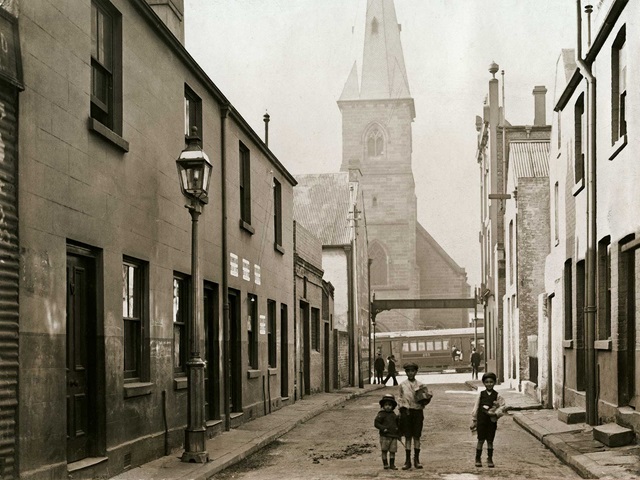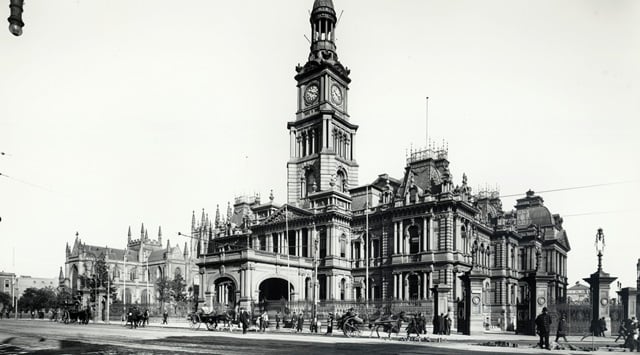History of Observatory Park
The Sydney Observatory built in 1857 to 1859 was a well-known landmark and soon gave its name to the hill on which it stood.

Observatory Park is bounded by Kent Street, Watson Road, Upper Fort Street and Bradfield Highway, Millers Point
The earliest European development on Observatory Hill was the construction of the first windmill by Irish convict John Davis in 1796. The windmill was a stone tower fitted with machinery to grind wheat to make bread. This windmill subsided in 1800 and lost its sails in a storm in 1805. By then another windmill had been built in timber to the south. These early structures gave rise to the name Windmill Hill, and the district still bears the name Millers Point.
As the highest hill overlooking the settlement of Sydney, this area was the site of Fort Phillip built in 1800 and named after the colony’s first Governor. The fort was armed with four 6-pounder cannons and a gunpowder magazine. The powder magazine was moved to Goat Island in 1833, and Fort Phillip was partially demolished in 1840. Upper Fort Street commemorates Fort Phillip.
With the growth in shipping the elevated site was used as a signal station from 1825, using flags and semaphore to communicate with ships from the east parapet of the fort. This gave the area the new name of Flagstaff Hill, and it was still referred to by locals as The Flaggie until well into the second half of the 20th century. In 1847 a 2-storey Telegraph House was built to meet increased demands of maritime activity in the port.
In 1825 the colony’s second hospital was built on the site, and after it was closed in 1848 it was converted into the Fort Street Model School, famous for its innovative teaching methods. At first it was co-educational but the boys moved to a new site at Taverner’s Hill, Petersham in 1916, where the high school (once again co-educational) still operates. Fort Street Public School is still at Observatory Hill.

The southern hemisphere was regarded as an important site for astronomical observations so the first observatory was built in Sydney in 1788. The observatory and astronomer’s residence were built here in 1857 to 1859, incorporating a time ball which signalled the time to shipping in the harbour each day. Due to increasing light and pollution the observatory closed in 1982 and is now a museum.
The 1880s Flagstaff planting scheme featured Moreton Bay fig trees many of which remain. A second phase of planting occurred in the 1930s after the completion of the Sydney Harbour Bridge, including a grove of palm trees next to its stairs. Observatory Hill contains many buildings which have been adapted for re-use over the decades, along with archaeological sites dating back to the beginnings of European settlement. From its elevated position it also offers one of the most spectacular vantage points in Sydney.
National Trust
The National Trust occupies the Fort Street School’s extension buildings completed in 1856. They were vacated by Fort Street Girls’ High School in 1974.
Observatory
The Sydney Observatory built in 1857 to 1859 was a well-known landmark in Sydney and soon gave its name to the hill on which it stood.
Boer War Memorial
This is Sydney’s main memorial to the volunteers who served in the Anglo-South African War of 1899 to 1902. It lists units rather than individual names and was erected in 1937.
Bureau of Meteorology
Rainfall on Observatory Hill is still a feature of Sydney weather reports. The Bureau of Meteorology moved here in 1908 although it has moved around the site over the years.
Agar Steps
These stairs from Observatory Hill down to Kent Street were built in 1892 and are regarded as the best example of many in the Millers Point district. They are named after Thomas Agars (1810-1862), a merchant at 105 Kent Street.
Bandstand Rotunda
The bandstand was built in 1912 and used for public musical performances. On the hill overlooking the Harbour and Bridge it is now a popular spot for weddings.
Further reading
Travis Partners, ‘Observatory Hill Conservation Management Plan’, 1987
DAW (Australia) Pty Ltd, ‘Observatory Hill Park Draft Plan of Management’, 1997
Cassie Futcher, ‘John Davis’ Windmill’, “History”, No 75 (March 2003)



